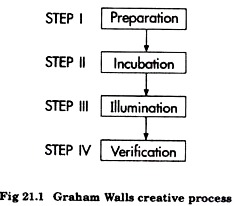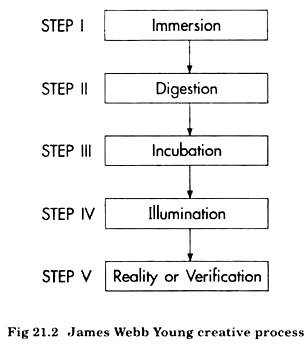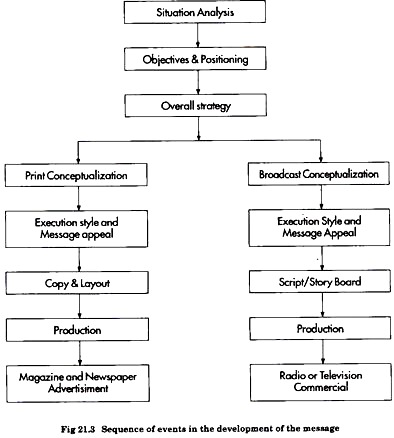After reading this article you will learn about the creative process in advertising.
Creativity in advertising does not exist in a vacuum. Productive originality and imagination are useful in all areas, even those that relate to such typically managerial tasks as the planning and organisation of advertising departments, and the establishment of controls.
In a recent survey of top managers in large corporation the lacks of innovative thinking in promotion was identified as a major concern. Specifically there appeared to be general unwillingness to take necessary risks, as well as inability to define new methods for promoting products to customers in the face of major increase in the cost of media advertising and personal selling.
The creative process is not a scientific process; rather it evolves from insight or inspiration. Nonetheless creativity in advertising must not only produce unique and interesting results, it must also produce useful solutions to real problems. Baker describes the concept of creativity as a pyramid divided into three parts.
Advertising creativity frequently takes off from a base of a systematic accumulation of facts and analysis. The second phase represents processing, or analysis, and the third part—the idea—is the culmination of creative efforts.
English sociologist Graham Walls outlined the four steps in creative process as follows (Fig. 21.1):
Step-I:
Preparation:
Gathering background information needed to solve the problem through research and study.
Step-II:
Incubation:
Getting away and letting ideas develop.
Step-III:
Illumination:
Seeing the light or solution.
Step-IV:
Verification:
Refining and polishing the idea and seeing if it is an appropriate solution. One of the most popular approaches to creativity in advertising was developed by James Webb Young, a former creative vice president at the J. Walter Thompson agency.
Young said that “the production of ideas is just as definite a process as the production of Fords; that the production of ideas, too, runs an assembly line; that in this production the mind follows an operative technique which can be learned and controlled; and that its effective use is just as much as a matter of practice in the technique as in the effective use of any tool”.
Young’s model of the creative process contain five steps (Fig. 21.2):
Step-I:
Immersion:
Gathering raw material and information through background research and immersing yourself in the problem.
Step-II:
Digestion:
Taking information, working it over, and wrestling with it in the mind. STEP-III
Incubation:
Putting the problems out of your conscious mind and turning the information over to subconscious to do the work.
Step-IV:
Illumination:
The birth of an idea—The “Eureka! I have it” phenomenon.
Step-V:
Reality or Verification:
Studying the idea to see if it still looks good or solves the problem, then shaping the idea to practical usefulness.
Model of the creative process are valuable to those working in the creative area of advertising, since they offer an organised way to approach an advertising problem. Preparation or gathering of information is the first step in the creative process.
The advertiser and agency start by developing a thorough understanding of the product or services, the target market, and the competition. Attention is also focused on the role of advertising in the marketing and promotional programme.
These models do not say much about how this information will be synthesized and used by the creative specialist because this part of the process is unique to the individual. In many ways, it is what sets apart the great creative minds and strategists in advertising.
Principles of Advertising Strategy:
As all advertising process begin with an advertising strategy. Advertising strategy is the formulation of advertising message that communicate the benefit or problem solution characteristics of the product or service to the market.
The message must be consumer oriented in meeting consumer needs or wants and must offer the desired consumer benefit, otherwise even a brilliant advertising strategy will not succeed. Hence, the advertising message must be the right one which when projected to the right audience at the right time, will bring the desired results.
Following principles (guide lines) are to be kept-in mind while formulating the advertising strategy:
(a) The consumer benefit must be directly related to the specific features of the product. This strategy would differentiate the product from the competitors. Then the consumer need or want associated with a particular brand reduces the competitor’s edge.
(b) Right type of media should be chosen for the product/service advertising for the proper and effective communication
(c) The benefit offered to the consumer must be wanted by the consumers. The product features offered must be what the consumer actually wants and not what the manufacturer thinks that the consumer wants.
(d) The advertising message must be clear that the product offered will solve a consumer problem and fulfill a consumer need or offer a consumer benefit. The benefit must be clearly communicated.


